/Contribution
What makes our food choice sustainable? Sustainability aspects of traditional diets – Three country perspectives

Introduction
How do we impact the environment and socio-economic systems on a global scale by our dietary habits? What are leverage points to shape food production and consumption patterns in a more sustainable way? And how could food be healthy for people and more sustainable in the future? The lecture Applied Developmet Research shed light into these current questions from three different countries’ perspectives.
The aim of the lecture was to illustrate sustainability aspects of our diets exemplified by traditional dishes of the countries Burkina Faso, Uganda and The Netherlands. Whereby the countries were selected according to the origin of some course members. Besides that, the seminar aimed at stimulating the reflection of dietary habits and current food production patterns by a collaborative cooking event* with stakeholder discussion - due to Covid19 the event had to be postponed until 2021. Under the umbrella of the SDGs, sustainability criteria were elaborated, and the dishes were evaluated on the level of ingredients. The interlinkages of the SDGs in food systems were especially highlighted. In the following fact sheets the student groups will present their main outcomes structured by the selected countries.
The countries
The Netherlands only counts a population of 17 million but manages to be the second biggest exporter of food in the world, as it also acts as a market entry to the European market. Concerning demand, global population size will continue to increase to probably to over nine billion by 2050. Regarding production, all three discussed countries will witness an intensified competition for land, water, and energy while climate change-related issues continue to be increasingly pressing and its effects are going to impede production in various forms (Foresight, 2011).
Burkina Faso, which is a low-income country in the west African Sahel region with growing economy (World Bank, 2020), depends heavily on agriculture, forestry and livestock farming (INSD, 2020). GDP per-capita remains one of the lowest in the world. According to the UNDP Human Development Index, ranked 183rd out of 186 in 2018, while Uganda was ranked 162nd and The Netherlands 10th. Burkina‘s population has more than tripled since the 60ies, now reaching approximately 20 million inhabitants. As a result of this tremendous population growths rate of 3% the country suffers even more from the effects of food insecurity and malnutrition (EU, 2020).
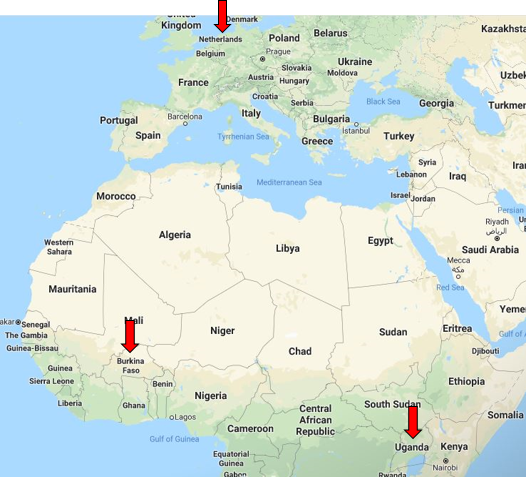
Figure 1: Northern and Central Africa, red arrows pointing to the two Burkina Faso and Uganda, the two African countries of concern in this study. Source: Google maps
But while Burkina Faso has rather poor soil, much of Uganda’s land is richly fertile. The most significant environmental problems in Uganda are draining of wetlands for agricultural use; overgrazing, soil erosion and deforestation; water hyacinth infestation in Lake Victoria; and poaching. Arable land comprises 35% and permanent cropland 11% of the total land area (BBC, 2018; Britannica, s.a.).
Agriculture contributes to about 20% of Uganda’s GDP, to 40% of the GDP in Burkina Faso and to less than two percent of the GDP of The Netherlands. Considering that distribution, the importance of agriculture in combating poverty in the rural areas of Uganda and Burkina Faso is obvious (Bernard, 2018; RGPH, 2006; Statista, 2020).
The Netherlands - *Winter Edition*
How can the most densely populated country of Europe be the second biggest exporter of food in the world? What traditional dishes do the Dutch eat to make them always win at speed ice skating? And what does it take to recreate those recipes in a country like Austria?
To answer those questions the following fact sheet will provide information on culture, sustainability, and recipes of three traditional Dutch winter dishes being;
- Erwtensoep or Snert (Peasoup)
Tradition: Eaten after new year dives, at Christmas markets and after outdoor ice skating.
Cooking time: 1h 45m
Ingredients: split peas, potatoes, carrots, onion, leeks, celery leaves, parsley.
Optional/Traditional: pork; belly, chop, Unox sausage.
winter dishes being;
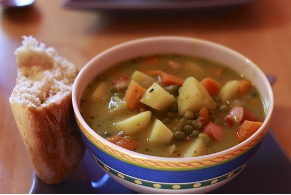
Source: Pixabay, kalhh, 2020
2. Stamppot or Hutspot (Mashed pot)
Tradition: Recipe originates from the cooked potato bits left behind by the fast departing Spanish soldiers during the siege of Leiden in 1574 being part of the 80-year long war of independence of the Netherlands.
Cooking time: 0h 35m
Ingredients: potatoes, carrots, onions, herbs, gravy.
Optional/Traditional: bacon, smoked Unox sausage.
Vegetarian/Vegan: lentil stew.
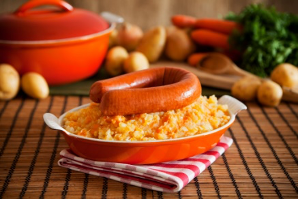
Source: Pixabay, Sara Winter, 2020
3. Hangop met Stoofpeer (Strained yoghurt with stewed pear)
Tradition: Both very traditional dishes and in comparison to the other dishes not found as readymade products in supermarkets.
Cooking time: 8h 30m
Ingredients: Gieser Wildeman Stoofperen, red wine, lemon, cinnamon, sugar, yoghurt, vanilla bean pod, whipping cream.
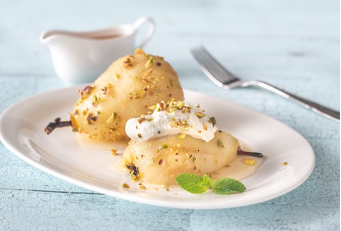
Source: Pixabay, AlexPro9500, 2020
Sustainability and Food Production
The topic of sustainability and how it relates to the production of food has been widely explored. In the following, a closer look into what sustainability in the context of food production means is taken. It is followed up with discovering Dutch food production from a sustainability perspective and concluded with the relation to the 3 national dishes.
Sustainability and Food: An overview
Our lives and quality of life depend heavily on the quality and quantity of food that is available to us. While it is fundamental to us, food production and food waste are leading causes to many environmental and social detriments. Numerous experts have postulated the urgent need for a turn to more sustainable practices within our food supply.
What is considered sustainable practice?
A very simple model to explain “sustainability” is widely accepted in the academic world (See Figure on the right; Sustainability), which explains it as a fine interplay between social, economic, and environmental factors (Linser, 1999). With the 17 SDGs, the United Nations have provided a principal framework on how we as humans should go forward while fostering social equity, environmental compatibility, and economic progress.
Hence, if considering sustainability of food, one ought to look at the whole complex web of socio-economic and environmental impacts that surround the food production chain.
Certain food items, by now widely known as for example soy or grain-fed meat, per calorie, require considerably more resources in their production and have a significantly higher environmental impact than others.
Other food items lead to the exploitation of social groups and the outrageous complexity of the world's free food market often leads to economic failure in certain branches, leaving non-resilient regions in economic despair.
Therefore, an exact examination of which ingredient is produced where, under which social and environmental circumstances, taking into consideration the associated transport, food waste, and disposal is needed.
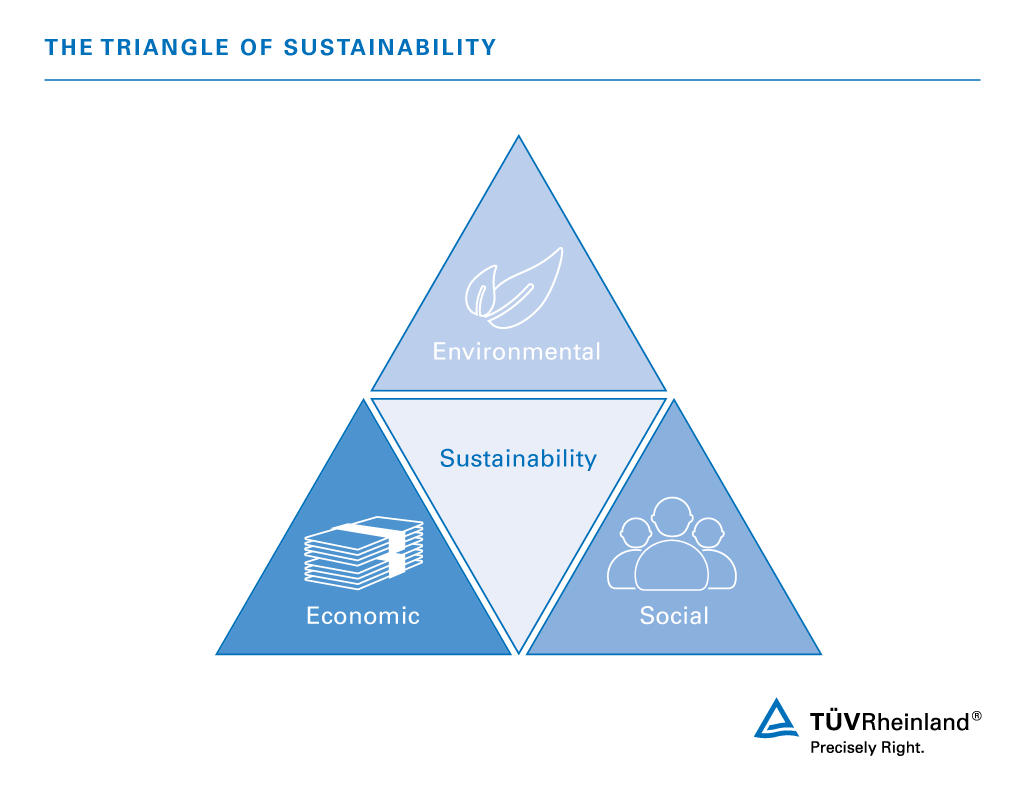
Figure 2: The three elements of sustainability after Linser, 1999
For the analysis, one should look at the way of production. While many of the ingredients in traditional dishes could actually be produced in the Netherlands, numbers of exports and imports show that just because a country produces a good, this is not a guarantee that all of what is consumed is produced locally.
Sustainability score in 4 factors:
- Production
- Transport/Infrastructure
- Innovative/Organic
- Social
Sustainability score is estimated rather positive (+), rather negative (-), or neutral (?). Score is also rated neutral if there is no sufficient data or information available. At first, information is provided about main ingredients of the three Dutch dishes, with lastly a concluding table including sustainability scores based on this information.
Peas
The Netherlands constitute a large producer of peas, however, according to data from the Statista Research Department, national production follows a decreasing trend (Statista, 2020). According to data from CBI (2020), the Netherlands are the biggest importer of Legumes from developing countries within the EU, mainly from Guatemala (3.1 thousand tonnes in 2017), Zimbabwe (2.5 thousand tonnes), Kenya (1.5 thousand tonnes) and Peru (one thousand tonnes). However, that does not imply that the Netherlands consumes all the imported goods, but also acts as a market entry to the European market, meaning that some of the produce is again exported. As the percentage of locally produced peas is not known, two scenarios are possible: Depending on the origin of the peas, the sustainability rating will score a totally different result. However, it is likely that peas are produced locally, hence the following can be concluded: Peas grow well in the Netherlands climatic zone, and as legumes can add to a healthy nutrient-cycling of crop fields, they are responsible for natural nitrogen fixation. Transport pathways are short. However, there is no data availability on organic farming or innovation for pea farming or social aspects.
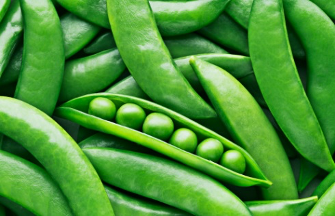
Source: Pixabay, Martin Barraud, 2020
Potatoes
Recent scientific articles of Wageningen University and Research (WUR) describe how sustainable hotspots for potato cultivation can be mapped and identified looking at environmental footprints (Haverkort, et al., 2013). Potatoes, being part of two of the presented Dutch dishes, grow locally and well in the Netherlands due to its cool temperate climate, rainy seasons, and influence by the atlantic ocean (Haverkort, 1990). They grow approximately between April and September, but can be stored for a long time on a cool and dark place which makes them an excellent winter dish ingredient. Generally, providing local food during winter is a challenge due to the lack of crops growing, making this winter edition factsheet extra interesting for picturing sustainability. There are similar conditions when it comes to carrot production in the Netherlands, as this vegetable is grubbed during autumn but can be delivered throughout the whole winter season (Buishand and de Jonge, 1981). In 2019, 5,262 million kg of potatoes for consumption (another 1,699 for starch) and 2,043.5 million kg of tuber and root vegetables (including carrots) were produced (CBS, 2020a). These are large amounts and export of goods benefits for economic development of the country. Organic production of potatoes for consumption and winter carrots is recently increasing (CBS, 2018).
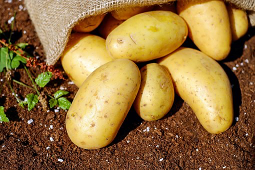
Source: Pixabay, Couleur, 2020
Meat
The production of meat has been criticized for its high environmental and climatic impacts, mainly due to deforestation of rainforest in developing countries to produce feed and methane emissions directly from the animal stock. Experts have demanded a reduction of animal proteins and a partial replacement with plant protein in the western world (de Boer et al., 2014) alongside with increasing local feed production. Meat consumption in the Netherlands shows a decreasing trend, however with around 85kg/year is still rather high in an international comparison (FAO, 2018) and the share of protein overconsumption is worrying (de Boer et al., 2006). On the production side, the Netherlands are a big player as well: 2018 they have produced around 3.6 million tons, just over half of it pork meat: 1.9 million tons of pork, 4,300 pig farms, with an average of nearly 2,900 pigs per farm. In the last decade, the number of pigs per company more than doubled, as well as local soy production has increased tenfold between 2013 and 2018 (number from 10 to over 90) (Statista, 2020). With this high amount of production and consumption, it is clear that the Netherlands cannot provide overall sustainable meat production: around 8 million tons of soy from outside Europe is used in animal production and 2015, 66 percent of soy used for animal feed was from unsustainable sources (IUCN, 2016). To summarize, the current situation of meat production in the Netherlands poses a major concern in the context of sustainable development. However, it is also a country where innovation happens and more sustainable ideas are pursued: The Netherlands show an increasing trend of organic pork and meat production (CBS, 2018), and they are also leaders in cultivated meat and main players pump high investments into research, even though a broad consumption of no-animal-meat still lays in the future (Fortune, 2020).
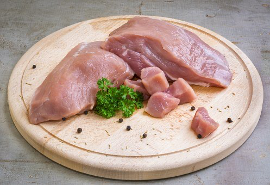
Source: Pixabay, StelaDi, 2020
Yoghurt (dairy production)
In order to produce yoghurt for the hangop, dairy is needed. Generally, dairy production is often criticized due to its methane emission contributing to global warming, involvement in acidification and eutrophication, and pressure on land and water usage (Nusbaum, 2010; Hollander, Temme and Zijp, 2017). However, in comparison to other countries the Netherlands is also known for its efficiency causing a tremendous increase in genetic merit of bulls in terms of production index (Pryce and Veerkamp, 1999). 99% of dairy cattle present in the Netherlands is the high producing locally Dutch-German sourced Holstein Friesian breed (picture on the right; Louwerens, 2017). Organic production of dairy and yoghurt is on the rise in the Netherlands with 37.26 million kg organic yogurt in 2017 compared to 21.77 in 2016 (Gu, 2016; CBS, 2018). Export of all this dairy might not be the most sustainable way of transportation. However, dairy processing infrastructure and therefore yogurt production within this small country uses short pathways, as 98% of Dutch milk is processed at 40 local factories (NZO, n.d.). Most dairy farms in the Netherlands are family farms mainly consisting of family labour (Samson, Gardebroek and Jongeneel, 2016).
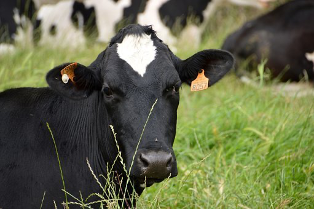
Source: Pixabay, VIVIANE6276, 2020
Red wine
In 2018, wine production in the country peaked at around 9,500 hectolitres, the highest volume reached in the surveyed period. The Netherlands does not really have a tradition of wine production. because the country’s climate is not suitable for the traditional grape varieties, such as Merlot and Cabernet Sauvignon. As a result, the Dutch mainly grow hardier grape varieties that are better suited to the cold. These are classic varieties like the Pinot Blanc, Pinot Gris and Chardonnay as well as younger varieties like the Regent, Cabernet Cantor, Pinotin, Riesel and Cabernet Blanc.

Source: Pixabay, congerdesign, 2020
Pear
The Dutch pear growers are expecting a good harvest of excellent quality this year. The harvest estimate is 352 million kilograms of pears. The surface of pears is now almost 2,000 hectares larger than the apple area. The Dutch fruit sector has benefited from a high consumption of pears from the start of the harvest season (September). The lights are therefore at green.
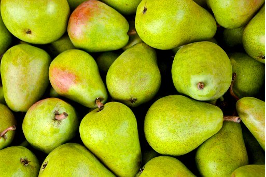
Source: Pixabay, Piro4D, 2020
Sustainability score table
Sustainability score table
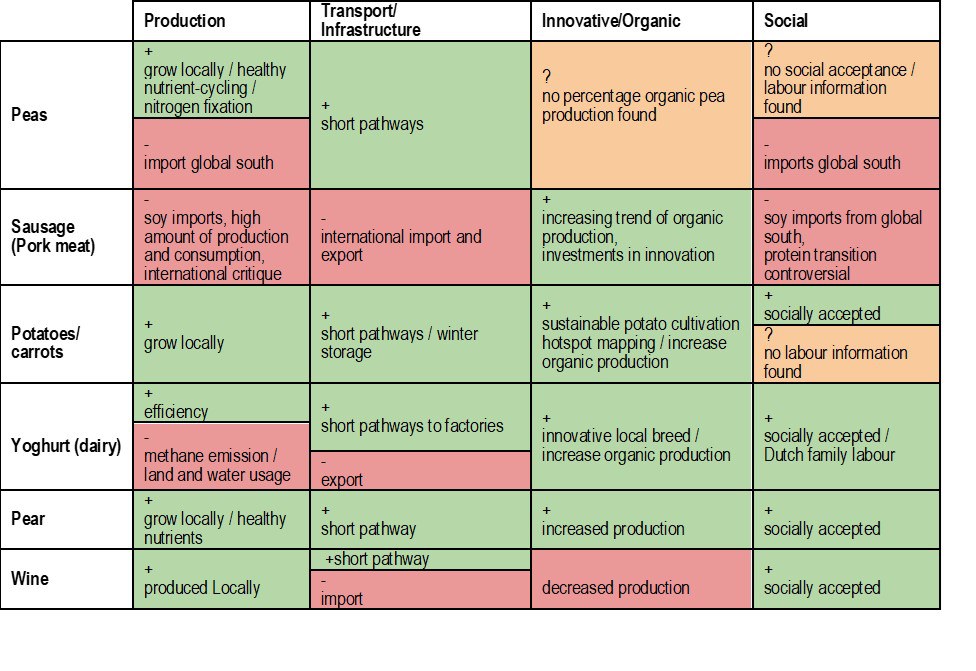
Quelle: Laura Hundscheid (2012)
Tab. 1: Sustainabillity score of the ingredients
Costs analysis
Costs in euros of main ingredients of all three Dutch dishes given per quantity (Kilogram or Litre) are displayed in the table below.
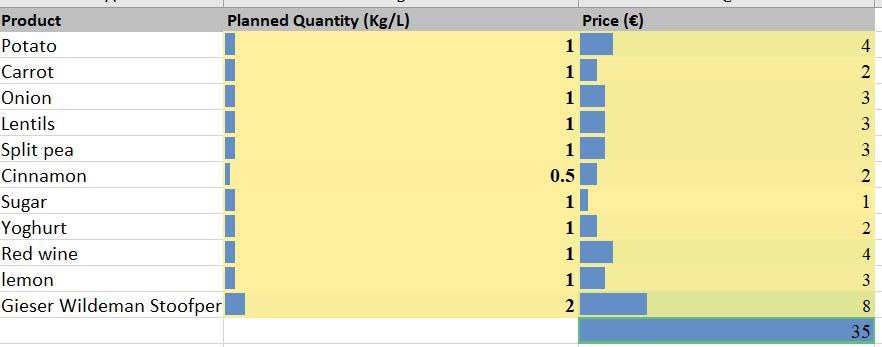
Tab. 2: Costs analysis of the ingredients (own illustration)
Key messages
The main messages or goals aimed for to achieve with this factsheet for the Netherlands are the following two:
1) Awareness raising among consumers & 2) Governmental involvement.
Key points and ways those can be achieved are the following:
1) Consumers awareness should be raised about:
- Protein transition (Vegetarian/vegan option of traditional dishes in this factsheet)
- Import/Export transport pathways (know where your food comes from)
- Nutrition for good health
2) Government should:
- Support local production and consumption
- Regulate import of legumes and soy
Foster protein transition
Burkina Faso
Beans
Cowpea (Vigna unguiculata L. Walp.) are the most important legumes that grow across the country. They are grown in the association with other cereals in about 80% of total cropland. Cowpea production is estimated at 10% of total crop production. During the last five years, its contribution to the GDP is estimated to 19 to 22 billion CFA on average. Despite its relatively small contribution compared to other traditional cereals, cowpea play an important role in the agricultural economy. It is not only central with regards to human nutrition and food security, but also generates income for both farmers and food vendors in the region. The grain is rich in protein (25%), carbohydrates, vitamins, and minerals, and complements the mainly cereal diet in countries that grow cowpea as a major food crop. In addition to the grain, the young green leaves and pods are consumed as a vegetable by the people; the haulms (biomass) from the plants provide important nutritious fodder for ruminants, especially during the dry season (Omoigui et al., 2018). Due to its precocity, cowpea is an important food source for the rural household during certain periods of the year, particularly when cereals are not available. Harvested early, cowpea provides income for rural households, which is then used to pay school fees, for example.
Adapted to a different type of soils (including poor and degraded soil) and different level of rainfall (400- 1200mm), its drought tolerance, its nutritional value for human (grain, leaves) and for animals (leaves and stem ) make it widely grow in the whole the country. There are two main systems of production:
Cowpea in association with other cereals to capture its ability to capture atmospheric nitrogen. This system represents 95 percent of the total bean land production. The production system with only pure cowpea occupied about 5 percent of the national total land production.
Shea butter
Shea butter is a multi-purpose cooking and skincare butter. It is a fat extracted from the nut of the African shea tree (Vitellaria paradoxa) (Image 2).
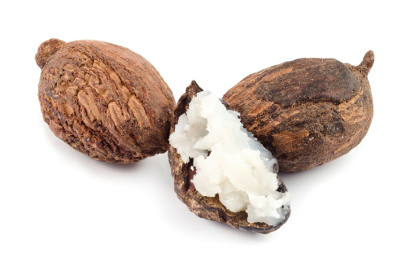
Shea fruits
Source: Pixabay, luisapuccini, 2020
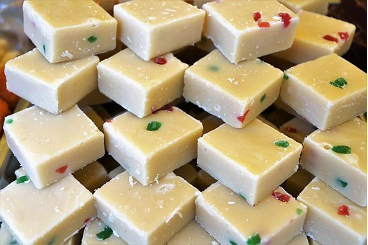
African shea butter is made from the nut of the Shea tree.
Source: Pixabay, photosforyou, 2020
Food grade raw shea butter is edible and used in many dishes. Shea butter has a very strong nutty taste and scent, is rich in Vitamins A, D, E, and K, and high in essential fatty oleic, stearic, linoleic, and palmitic acids. Shea butter, also known as Women's Gold in Africa, plays a crucial role in cooking, skin care and earning living wages for millions of African women.
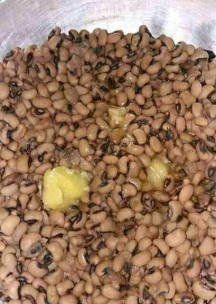
Boiled cowpea in shea butter
Source: Foto by Bienvenue Lassima Zooma, 2019
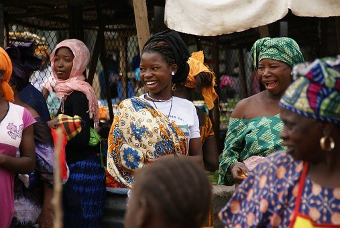
Local market as a typical place to get shea butter.
Source: Pixabay, hnijssen, 2020
Shea has long been recognized for its emollient and healing properties, ideal for soothing skin in the dry climate of the region. Reports of its use go back as far as the 14th century.
Cowpea as food - Tradition and consumption
Cowpea cooking requires rather few ingredients. Thus, it is usually cooked for many social events such as weddings, funerals, mutual aid during crop activities (harvesting), and other community activities such as house building. Cowpeas are commonly consumed in Burkina Faso, both in rural and urban areas. Due to its high amount of protein, it is usually called “the meat of the poor". There are different types of cowpea-based dishes:
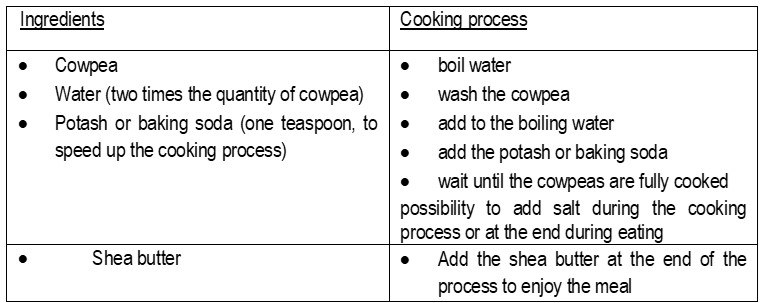
Tab. 1.1: Recipe of cowpea with shea butter
Cost calculation
For the cooking event we prepare our dish “Cowpea with shea butter” for 15 people. Therefore, we need 4 kg of cowbeans, 1 kg of shea butter and 75g of salt, 8 litres of water, potash or baking soda. The total cost belongs around 9.39 Euro. Per Person one meal will cost 0.63 Euro.

Tab. 1.2: Cost calculation
Sustainability criteria - What makes our food choice sustainable?
FAO developed a common vision for sustainable food and agriculture by setting five key principles. In this vision, farmers have the opportunity to actively participate in, and benefit from, economic development, have decent employment conditions and work under fair price conditions. Rural women, men, and communities live in food security, and have control over their livelihoods and equitable access to resources which they use in an efficient way. Building on extensive work that promotes sustainability in various production systems, FAO proposes to integrate these into a single Sustainable Food and Agriculture approach. This approach has been developed to support and accelerate the transition to more sustainable food and agriculture systems. The approach is based on five principles that balance the social, economic and environmental dimensions of sustainable food and agriculture. They provide a basis for developing adapted policies, strategies, regulations and incentives (FAO, 2014).
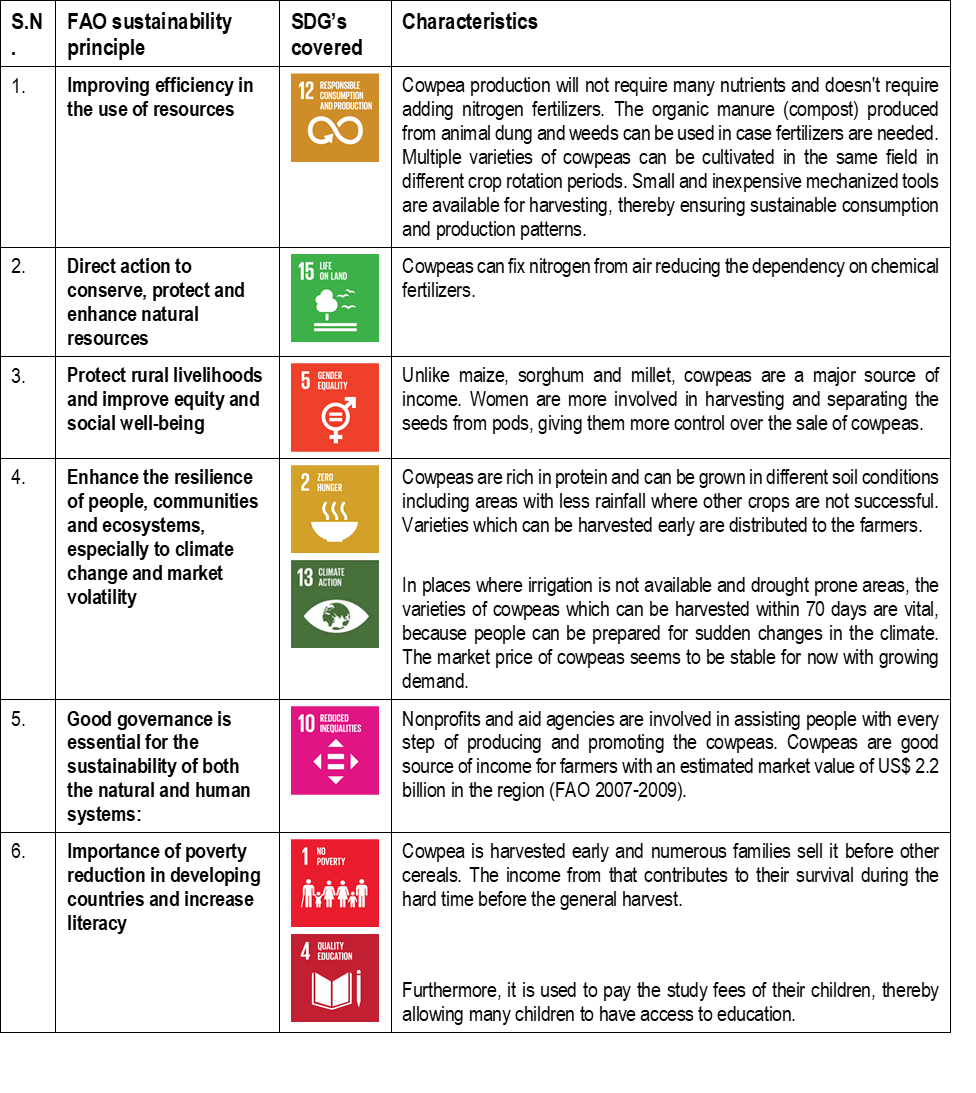
Tab. 1.3: Sustainability Criteria
Production sustainability
Like other countries in the Sahel Region, Burkina Faso is prone to drought and floods. This results in land degradation and desertification. Additionally, low soil quality is the reason why farming in Burkina Faso comes with its challenges. Only 13% of the country’s land is under annual or perennial crops. Furthermore, tough climate-related events threaten livelihoods and food security. Therefore, farmers need to come up with innovative and sustainable solutions on how to grow food under these conditions. One of these so called “climate-smart agriculture methods” works by digging small holes or planting pits on degraded land and filling them with organic matter. This enables nutrients to enter, so it is possible to sow crops. Additionally, a technique was invented to slow down water runoff, prevent erosion, and assist in recharging the groundwater. This water-harvesting technique works by constructing stone lines on the farmland. It also allows farmers to restore completely degraded land to significantly higher levels of production. This shows that the agriculture practiced in Burkina Faso is very sustainable and also enables small, rural farmers to produce food and, thus, helps to secure the country.
Cowpea also plays an important role in providing soil nitrogen to cereal crops (such as maize, millet, and sorghum), when grown in rotation, especially in areas where poor soil fertility is a problem. It does not require a high rate of nitrogen fertilization; its roots have nodules in which soil bacteria called Rhizobia help to fix nitrogen from the air, some of which is left behind in the soil for subsequent crops after harvesting. The crop also grows and covers the ground quickly, preventing erosion (Omoigui et al., 2018). All parts of the bean plant can be used, and apart from the bean, young leaves are also eaten by locals. Older leaves and the stems are used as fodder for animals (goats, sheep, cattle) and roots are left in the soil as organic matter and for nutrient recycling.
Shea butter is derived from the seed of Vitellaria paradoxa. The fruit pulp is eaten as it is rich in nutrition. The pulp is eaten by adding lemon to neutralize the taste as it is quite overpowering. Shea butter is an organic product and promoting this will enhance the protection of the shea tree. Women are involved in harvesting the fruits and processing shea butter. It has become a proven income-generating activity for them, leading to financial independency.
Key messages
- Agriculture contributes to about 40% of GDP in Burkina Faso
- It is vital to produce local food like the Cowpea, because it plays an important role in the agricultural economy
- The production of the beans is very sustainable, especially because the whole plant and not only
- Cowpea and shea butter production meet several SDGs
Uganda
Agricultural and Food Production
Uganda’s agricultural sector is made up of three subsectors: crop, animal, and fisheries. In total, Uganda holds 11 different farming systems, depending on climatic, topographic and socioeconomic characteristics. The north-eastern regions are characterised by annual crops such as cereals and cattle farming, whereas the lower regions to the southwest and the shores of Lake Victoria are used to produce bananas and coffee (Kaizzi, s.a.).
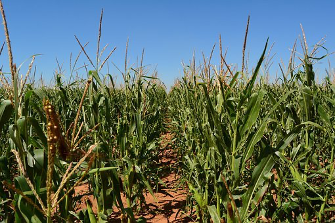
Source: Pixabay, WhiskerFlowers, 2020
Cereals, including maize, finger millet, and sorghum provide staple food for over 50% of the country’s population. Simultaneously cereal crops are “playing an increasing role in the provision of incomes of the rural households and the national economy” (GOU, 2010). Even though these cereals can be cultivated throughout the country, the amount of rainfall is the limiting factor to distinguish high potential growing areas. As rainfall is generally predicted to decline in duration and reliability in the future, crops that thrive in low-rainfall environments, like sorghum, are predicted to get more important for Uganda’s crop selection (Pendera et al., 2004).
Maize
With almost 2.5 million metric tons per year, maize is the number one cereal in Uganda. Most intensely cultivated in eastern, central and western parts, over 90% of it is produced by small-scale farmers, “of which about 60% of the annual maize output is consumed on the farm” (GOU,2010). The crop can be grown two times a year. Only depending on rainfall, it can be harvested as long as it gives reasonable yields (Bernard, 2018).
Finger Millet
The production of the second most important cereal in Uganda is concentrated in the eastern and northern areas of the country. While many are very sensitive to water shortages, finger millet has the ability to resist unexpected strikes by changing weather conditions. It is a staple food across most regions in Uganda, with families enjoying its paste and brown local porridge as well as its use to brew alcoholic beverages (Kaizzi, s.a.).
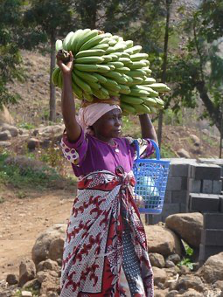
Source: Pixabay, 11mela, 2020
Sorghum
The wide-spread cereal sorghum is one of the major crops in Uganda and is widely grown in the country’s short grass areas of the northern, eastern and south-western regions of the country. In some regions it occupies 80% of the agricultural land. Its high tolerance to drought, compared to maize or finger millet, makes it a very important food security crop and plays a major role in many rural households (Kaizzi, s.a.).
Rice
Although rice is not a traditional food in Uganda it is widely spread and consumed.
There is an increase in rice production because of the increased demand and the stability of farm-gate and retail prices. A government policy that encourages farmers to grow rice so as to ensure food security for this commodity, alleviates poverty and reduces the need to import rice. Among the crops grown in Uganda, rice is second to none in economic returns to the smallholder farmers on the basis of labour per man-day per ha (Pendera et al., 2004).
Matooke (plantain)
Around the East African Great Lakes region, the highland cooking banana is the most important crop. Even though the crop has its roots in the central regions of Uganda, the production areas of the lucrative crop have expanded towards the south-west of the country, where it has replaced the cultivation of finger millet. The possibility to intercrop bananas with coffee, beans, and yams makes it a good choice for smallholder farmers with limited access to land and labour (Ebanyat et al., 2010).
Sustainability Criteria
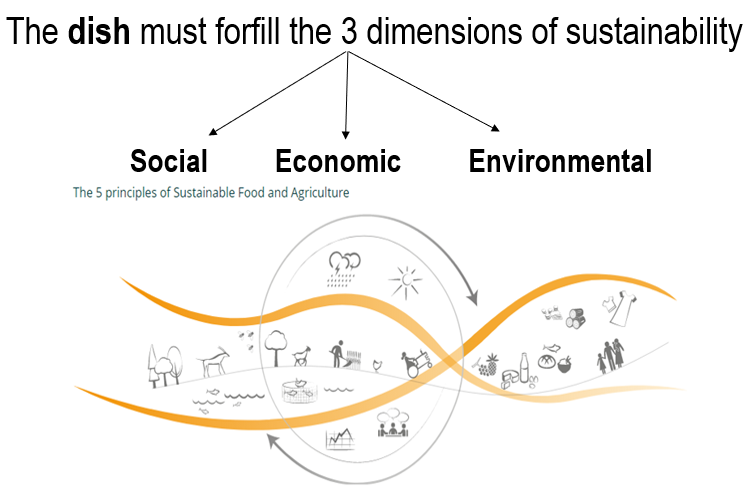
Sustainability Criteria
A common vision for Sustainable Food and Agriculture must equally address social, economic and environmental dimensions to ensure sustainability. Neglecting any area jeopardizes the attainment of sustainability in others.
The FAO principles (FAO, 2014) of sustainable food and agriculture are summarized as:
- Increase productivity, employment and value addition in food systems
- Protect and enhance natural resources
- Improve livelihoods and foster inclusive economic growth
- Enhance the resilience of people, communities and ecosystems
- Adapt governance to new challenges
In order to stick to FAO guidelines (http://www.fao.org/sustainability/en/), we divided our criteria in three categories Economic, Social, Environmental, which are of course interrelated. Starting from a global perspective, we made the attempt to find a declination of such principles for the Ugandan context. Factors such as economic, climatic and technological limitations as well as certification issues have been taken into account in this phase.
We chose to select local fresh food from smallholder farmers according to the principles 3 and 4. To promote environmental sustainability, we selected products from organic agriculture, with a focus on traditional varieties, in line with principles 1 and 2. Organic fresh products are assumed to be healthy and thus to promote social sustainability as well. Fresh organic products can be certified according to international ST D's as well as with a local Participatory Guarantee System (Katto-Andrighetto, 2013). This is important in order to include those small farmers who are not able to afford international certification and to promote local organic movement. In the case of industrial products such as sunflower seeds oil (The International Trade Centre, 2016), and salt, if alternatives from farmers are not available, we opted for a „Made in Uganda“ criterion in order to reduce transportation and promote local economy and employment (principle 1).
A limitation in our case study is the assumption that family labour is in line with fair labour ST D's.
Eventually we selected an affordability threshold in order to express our vision that “sustainable food“ is a right and not a privilege and has to be accessible to everyone. The results are some guidelines addressing Ugandan consumers who are sensitive to sustainable food production and consumption. A final step to reinforce the coherence of the local criteria/guidelines in the global context is through a comparison with the SDGs by the UN. We found a relationship between our criteria and 7 of the SDGs. The results are presented in the following table.
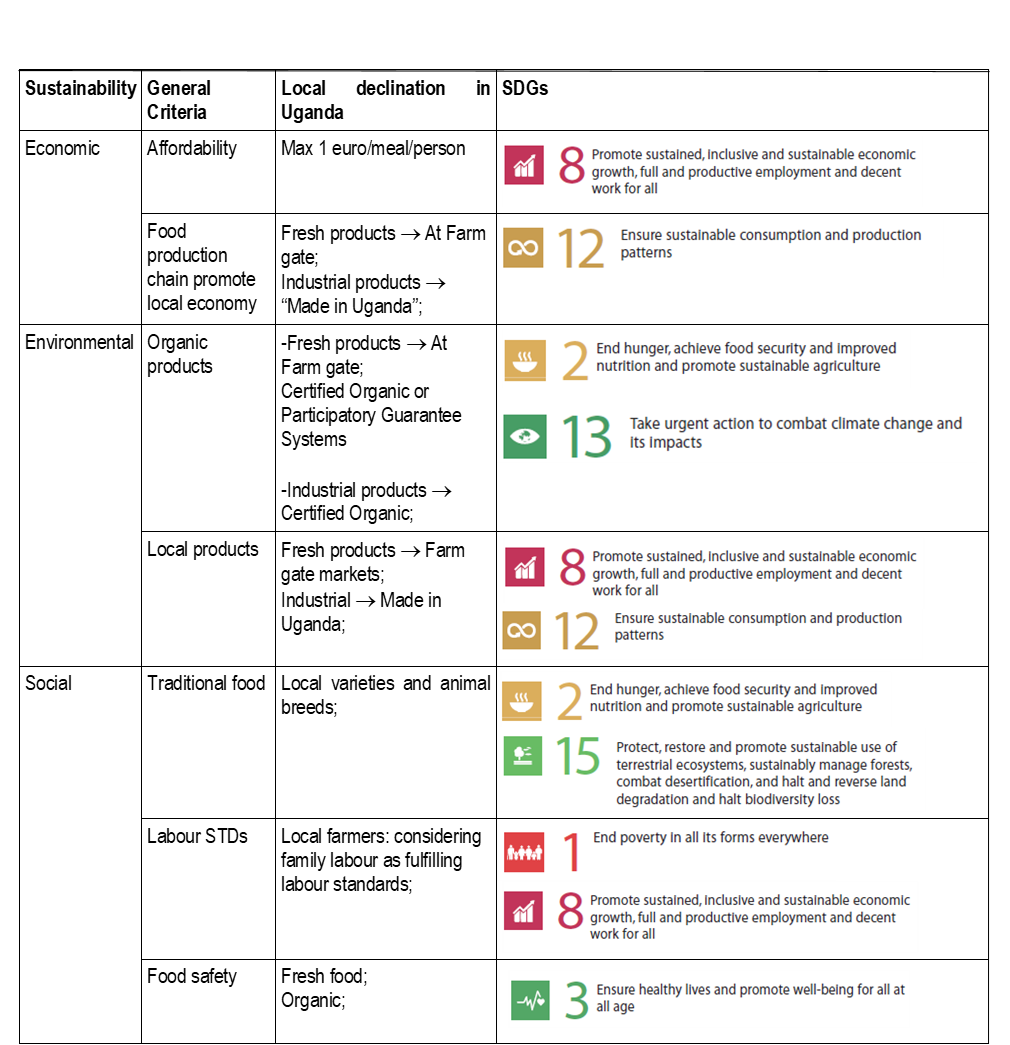
Tab. 3.1: Relationship between sustainability criteria and Sustainable Development Goals
The Recipe: Luwombo
Oluwombo or luwombo was originally created in 1887 by the personal chef of Kabaka Mwanga, king of Buganda (Ugandan region where the country got its name from), at the end of the nineteenth century. It is a tribal food well known across central Uganda and a fairly common dish cooked for special events. The nutritious meal only consists of ingredients that can be grown locally.
Besides some different varieties of spicing, the main ingredients are Matooke (plantain), meat, groundnut, sweet potato, onion, tomato, banana leaves, salt, pepper, cooking oil, rice. Water and charcoal as fuel are needed for cooking. Adding mushrooms and smoked fish or meat is also possible.
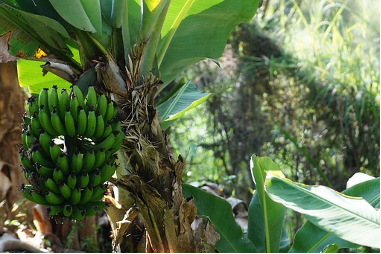
Source: Pixabay, ceguito, 2020
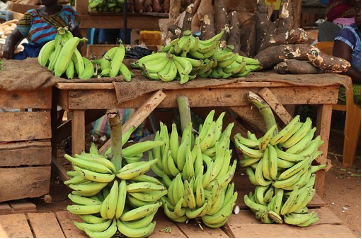
Source: Pixabay, foto-augenblick, 2020
How to cook Luwombo
Sauté the meat in a lightly oiled pan until browned on all sides. Set aside. Heat a tablespoon of oil in a pan, then add the onions and cook for 2 minutes before adding the tomatoes, salt, pepper, peanuts. If necessary, add a little water to form a smooth sauce. Simmer for 8-10 minutes. Add meat and mix.
Cut banana leaves to form 10-inch wide rectangles. Remove the mid rib. Place the banana leaves above of a fire for a few seconds to soften. Then rinse with water. Place a portion of the meat mixture in the center of a leaf. Fold the leaf on the sides, then fold the other two ends to form a small pouch. Tie with a string then repeat with the operation with the rest of the mixture. Place a rack in the bottom of a large pot and add water to the bottom. Place the pouches on top of the rack and cover.
Add the plantains over in the pan. Bring to a boil and steam for at least two hours. Take plantains out of the pot and mash with a fork. Serve luwombo with mashed plantains and rice on a side.
Cost calculation
This cost calculation is based on a meal served to five persons. Estimated price list is available online (NUMBEO 2020).
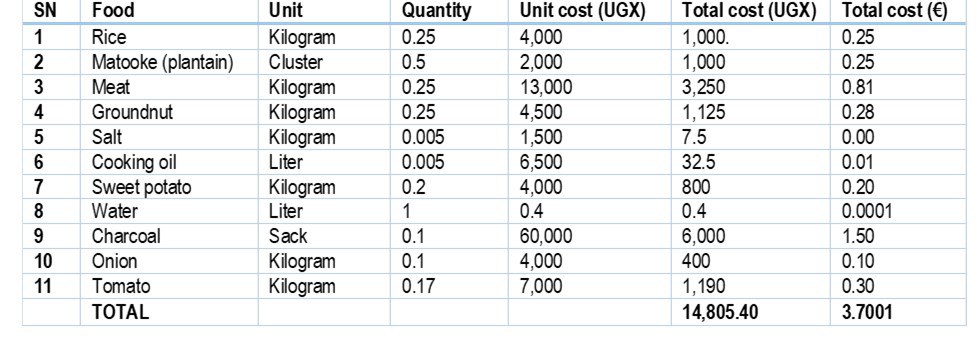
Tab. 3.2: Cost calculation
Key message
Almost three quarters of Uganda’s inhabitants older than 10 years work in agriculture. A large part of the population survives on small-scale farming, however incidence of poverty is higher in rural areas compared to the city. Moreover, environmental issues such as overgrazing, soil erosion, and deforestation put the country in a vulnerable position facing climate change. Investments and development programs in small-scale sustainable farming are of great importance to allow inclusive economic development (SDG 8), as well as reducing hunger and poverty (SDGs 1 and 2). Improvements in small-scale organic farming would promote production and consumption of healthy food, preserve the use of local crop varieties and traditional dishes (SDGs 3 and 13). Eventually, compared to industrial monoculture, small holders farming shows high biodiversity, thereby enhancing community resilience and adaptation to climate change (SDGs 13 and 15). Therefore, “modernization” processes and government programs within the Country should be centered on small-scale farming in order to fulfill the three dimensions of sustainability.
References
References:
EU 2020: https://ec.europa.eu/international-partnerships/where-we-work/burkina-faso_en accessed July 2020.
Google INEGI, 2020. Mapdata. https://www.google.com/maps
Neatherland
Boer, J. D., Helms, M., & Aiking, H. (2006). Protein consumption and sustainability: Diet diversity in EU-15. Ecological Economics, 59(3), 267–274. doi: 10.1016/j.ecolecon.2005.10.011
Boer, J. D., Schösler, H., & Aiking, H. (2014). “Meatless days” or “less but better”? Exploring strategies to adapt Western meat consumption to health and sustainability challenges. Appetite, 76, 120–128. doi: 10.1016/j.appet.2014.02.002
Buishand T.J. and de Jonge P. (1981). Teelt van winterpeen. Teelthandleiding nr. 6. Edelhertweg 1, postbus 430, 8200 AK Lelystad.
Centraal Bureau voor de Statistiek (CBS/Statistics Netherlands) (2020a). Landbouw; vanaf 1851.
Centraal Bureau voor de Statistiek (CBS/Statistics Netherlands) (2020b). Melkaanvoer en zuivelproductie door zuivelfabrieken.
Centraal Bureau voor de Statistiek (CBS/Statistics Netherlands) (2018). Biologische landbouw groeit. https://www.cbs.nl/nl-nl/nieuw... (accessed 10.06.2020).
CBI (Centre for the Promotion of Imports from developing countries): Exporting fresh beans, peas, and other leguminous vegetables to Europe (2020).
https://www.cbi.eu/market-information/fresh-fruit-vegetables/beans-peas-other-leguminous-vegetables/ (accessed 26.05.2020)
CBS 2018, Biolologische landbouw groeit. (https://www.cbs.nl/nl-nl/nieuw...) (accessed 10.06.2020)
FAO (2018). Meat Consumption Netherlands 2018. http://www.fao.org/faostat/en/#search/meat%20consumption (accessed 11.06.2020)
Foresight. The Future of Food and Farming (2011) Final Project Report. The Government Office for Science, London.
Fortune A. 2020, still early days for cultivated meat - Mosa meat. https://www.globalmeatnews.com/Article/2020/01/24/Still-early-days-for-cultivated-meat-Mosa-Meat (accessed 10.06.2020 )
Gu S. (2016). Comparing Organic and Conventional Dairy Farms in the Netherlands – A Monte Carlo Analysis.
Haverkort A.J. (1990). Ecology of Potato Cropping Systems in Relation to Latitude and Altitude. Agricultural Systems. 32:251-272.
Haverkort A.J., de Ruijter F.J., van Evert F.K., Conijn J.G. and Rutgers B. (2013). Worldwide Sustainability Hotspots in Potato Cultivation. 1. Identification and Mapping. Potato Research. 56:343–353.
Hollander A., Temme E.H.M and Zijp M.C. (2017). The environmental sustainability of the Dutch diet: background report to ‘What’s on our plate?’: safe, healthy and sustainable diets in the Netherlands.
IUCN (2016). 66 percent of Soy of the Netherlands still unsustainable. https://www.iucn.nl/en/updates/66-of-soy-used-in-the-netherlands-still-unsustainable (accessed 11.06.2020)
Linser S. (1999). Theoretical background of indicators and indicator systems for the assessment of sustainable development. In book: Regional Forest Programmes: A Participatory Approach to Support Forest Based Rural Development, Edition: EFI Proceedings 32, Publisher: Niskanen, A.; Vayrynen, J. (eds), European Forest Institute, Joensuu, Finland, pp.205-221.
Louwerens T. (2017). Meet the Dutch heritage cattle breeds. Resource. Science.: April 20, 2017.
Nederlandse Zuivel Organisatie (NZO). (non-determined; n.d.). Leden. https://www.nzo.nl/organisatie... (accessed 10.06.2020).
Nusbaum N.J. (2010). Dairy Livestock Methane Remediation and Global Warming. Journal of Community Health. 35: 500–502.
Pryce J.E. and Veerkamp R.F. (1999). The incorporation of fertility indices in genetic improvement programmes. Fertility in the high producing dairy cow. British Society of Animal Science (BSAS) 26: 237-250.
Samson G.S., Gardebroek C. and Jongeneel R.A. (2016). Explaining production expansion decisions of Dutch dairy farmers. NJAS - Wageningen Journal of Life Sciences. 76: 87-98.
Sikkema A. (2020). Wageningen is the best agricultural university in the world again. Resource. MARCH 18, 2020.
Statista Research Department. (2020). Production of Peas in the Netherlands. https://www.statista.com/stati... (accessed 26.05.2020)
Statista Research Department (2020). Netherlands: distribution of gross domestic product (GDP) across economic sectors from 2008 to 2018.
https://www.statista.com/stati... (accessed 22.07.2020)
Statista Research Department (2020). Number of Soy farmers in the netherlands. https://www.statista.com/stati... (accessed 10.06.2020)
Statista Research Department (2020). Meat Production in the Netherlands. https://www.statista.com/stati... at: (accessed 10.06.2020)
List of Tables
2.1: Sustainability score of the ingredients (own representation)
Burkina Faso
Burkina Faso, 2008. Recensement général de la population et de l´habitat de 2006: résultats définitifs, 52p.
BUP, Divine Nde, MOHAGIR, Ahmed Mohammed, KAPSEU, César, et al. Production zones and systems, markets, benefits and constraints of shea (Vitellaria paradoxa Gaertn) butter processing. OCL, 2014, vol. 21, no 2, p. D206.
FAO, 2013. Cadre de Programmation pays 2013-2015, Burkina Faso, 60p.
FAO, 2014. Building a common vision for sustainable food and agriculture PRINCIPLES AND APPROACHES. Rome 2014, http://www.fao.org/3/a-i3940e.pdf
FAO. “Integrated production and pest management program in Africa. Regional and country projects. Burkina Faso. www.fao.org/agriculture/ippm/projects/burkina-faso/en/ (Last modified July 22, 2020).
INSD 2020. Annuaire statistique. Institut National de la Statistique et de la Demographie, Ministere de l´Economie et des Finances. Ouagadougou: Burkina Faso. https://www.insd.bf
Ishikawa, H., Drabo, I., Muranaka, S. and Boukar, O. 2013. Cowpea field guide for Burkina Faso. IITA, Ibadan, Nigeria. 30 pp
New Agriculturist. “Country profile- Burkina Faso. Last modified July 22, 2020.
http://www.new-ag.info/en/country/profile.php?a=2
Omoigui, L.O. Kamara, A.Y., Batieno J., Iorlamen, T., Kouyate, Z., Yirzagla, J., Diallo, S., and Garba, U.. 2018. Guide to cowpea production in West Africa, IITA/CGIAR
Schmidt, M., & Chatelain, C. 2017. Diversity, distribution and preliminary conservation status of the flora of Burkina Faso. Magnolia Press.
USAID. “Agriculture & Food security. Burkina Faso fact sheet. Last updated July 02, 2020. https://www.usaid.gov/burkina-...
Wikipedia. “Agriculture in Burkina Faso”. https://en.wikipedia.org/wiki/... (Last modified July 22, 2020).
Winterbottom R., Landsberg F. and Reij C. 2013. Burkina Faso farmers leads the way on food security and climate change resilience. https://www.wri.org/blog/2013/...
Worldbank. “Burkina Faso: Agriculture as a powerful instrument for poverty reduction”. https://www.worldbank.org/en/results/2017/06/29/burkina-faso-agriculture-as-a-powerful-instrument-for-poverty-reduction (Last modified July 22, 2020).
https://www.iita.org/wp-conten...
https://www.mc-cube.at/tag/sdg/ (Last modified July 22, 2020)
https://sustainabledevelopment.un.org (Last modified July 22, 2020)
https://www.theafricangourmet.com/2018/02/better-cooking-with-shea-butter.html
https://www.thesheatree.com/about-us/
https://data.worldbank.org/indicator/NY.GDP.MKTP.KD.ZG (Last modified June 15, 2020).
List of Tables
Table 1.1: Recipe of cowpea with shea butter (own representation)
Table 1.2: Cost calculation (own representation)
Table 1.3: Sustainability criteria (own representation)
Uganda
Bagamba, F., 2008. Market acces and agricultural production: the case of banana production in Uganda. Wageningen University, The Netherlands.
Bernard, B., 2018. An AgriFoSe2030 final report from Subtheme 1,Social and economic dimensions of smallholder based agriculture and food security. Department of Geography, Geo-Informatics and Climatic Sciences, College of Agricultural and Environmental Sciences, Makerere University. Kampala. BBC News, Uganda Country profile, s.a. Available in : https://www.bbc.com/news/world-africa-14107906 Britannica Encyclopedia, s.a. Uganda Country Profile. Available in: https://www.britannica.com/place/Uganda
Freeworldmaps (2017): Uganda Physical Map. Online available in : https://www.freeworldmaps.net/...
Kaizzi, K. s.a. Description of cropping systems, climate, and soils in Uganda. http://www.yieldgap.org/uganda
Katto-Andrighetto, J. (2013). Participatory Guarantee Systems in East Africa. Case Studies from Kenya, Tanzania and Uganda. Ifoam, 14–18.
Pendera J., Nkonya P., Jagger, P., Sserunkuumab, D., Ssali, H., 2004. Strategies to increase agricultural productivity and reduce land degradation: evidence from Uganda. Makerere University, Kampala, Uganda.
The International Trade Centre (ITC). (2016). Value chain roadmap for sunflower 2016-2020. 55–56. http://www.fao.org/sustainability/en/
Uganda National Web Portal, s.a. Available in: https://www.gou.go.ug/
https://www.196flavors.com/uganda-luwombo/
List of Figures and Tables
Figure 1: Sustainability criteria (own representation)
Table 3.1: Sustainability criteria and the relation with SD G's (own representation)
Table 3.2: Cost calculation (own representation)
